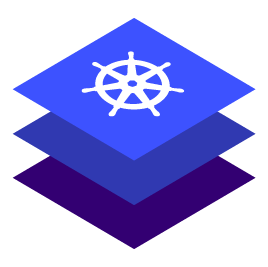vSphere Air-gapped: Create a CAPI VM Template
You must have at least one image before creating a new cluster. As long as you have an image, this step in your configuration is not required each time since that image can be used to spin up a new cluster. However, if you need different images for different environments or providers, you will need to create a new custom image.
Using KIB, you can create your VM template without requiring access to the internet by providing an additional --override flag.
Assuming you have downloaded
dkp-air-gapped-bundle_v2.6.2_linux_amd64.tar.gz, extract the tarball to a local directory:CODEtar -xzvf dkp-air-gapped-bundle_v2.6.2_linux_amd64.tar.gz && cd dkp-v2.6.2/kibFollow the instructions to build a vSphere template below and set the override
--overrides overrides/offline.yamlflag.
Create a vSphere Template for Your Cluster from a Base OS Image
Using the base OS image created in a previous procedure, DKP creates the new vSphere template directly on the vCenter server.
Set the following vSphere environment variables on the bastion VM host:
CODEexport VSPHERE_SERVER=your_vCenter_APIserver_URL export VSPHERE_USERNAME=your_vCenter_user_name export VSPHERE_PASSWORD=your_vCenter_passwordCopy the base OS image file created in the vSphere Client to your desired location on the bastion VM host, and make a note of the path and file name.
Create an
image.yamlfile and add the following variables for vSphere. DKP uses this file and these variables as inputs in the next step.
⚠️ NOTE: This example is Ubuntu 20.04. You will need to replace OS name below based on your OS. See other YAML examples for copy and paste below last step.CODE--- download_images: true build_name: "ubuntu-2004" packer_builder_type: "vsphere" guestinfo_datasource_slug: "https://raw.githubusercontent.com/vmware/cloud-init-vmware-guestinfo" guestinfo_datasource_ref: "v1.4.0" guestinfo_datasource_script: "{{guestinfo_datasource_slug}}/{{guestinfo_datasource_ref}}/install.sh" packer: cluster: "<VSPHERE_CLUSTER_NAME>" datacenter: "<VSPHERE_DATACENTER_NAME>" datastore: "<VSPHERE_DATASTORE_NAME>" folder: "<VSPHERE_FOLDER>" insecure_connection: "false" network: "<VSPHERE_NETWORK>" resource_pool: "<VSPHERE_RESOURCE_POOL>" template: "os-qualification-templates/d2iq-base-Ubuntu-20.04" # change default value with your base template name vsphere_guest_os_type: "other4xLinux64Guest" guest_os_type: "ubuntu2004-64" # goss params distribution: "ubuntu" distribution_version: "20.04" # Use following overrides to select the authentication method that can be used with base template # ssh_username: "" # can be exported as environment variable 'SSH_USERNAME' # ssh_password: "" # can be exported as environment variable 'SSH_PASSWORD' # ssh_private_key_file = "" # can be exported as environment variable 'SSH_PRIVATE_KEY_FILE' # ssh_agent_auth: false # is set to true, ssh_password and ssh_private_key will be ignoredCreate a vSphere VM template with your variation of the following command:
CODEkonvoy-image build images/ova/<image.yaml>Any additional configurations can be added to this command using
--overridesflags as shown below:Any credential overrides:
--overrides overrides.yamlfor FIPS, add this flag:
--overrides overrides/fips.yamlfor air-gapped, add this flag:
--overrides overrides/offline-fips.yaml
The Konvoy Image Builder (KIB) uses the values in
image.yamland the input base OS image to create a vSphere template directly on the vCenter server. This template contains the required artifacts needed to create a Kubernetes cluster.
When KIB provisions the OS image successfully, it creates a manifest file. Theartifact_idfield of this file contains the name of the AMI ID (AWS), template name (vSphere), or image name (GCP/Azure), for example:CODE{ "name": "vsphere-clone", "builder_type": "vsphere-clone", "build_time": 1644985039, "files": null, "artifact_id": "konvoy-ova-vsphere-rhel-84-1.21.6-1644983717", "packer_run_uuid": "260e8110-77f8-ca94-e29e-ac7a2ae779c8", "custom_data": { "build_date": "2022-02-16T03:55:17Z", "build_name": "vsphere-rhel-84", "build_timestamp": "1644983717", [...] } }Recommendation: Now we can now see the template created in our vCenter, it is best to rename it to
dkp-<DKP_VERSION>-k8s-<K8S_VERSION>-<DISTRO>, likedkp-2.6.2-k8s-1.26.14-ubuntuto keep templates organized.Next steps are to deploy a DKP cluster using your vSphere template.
